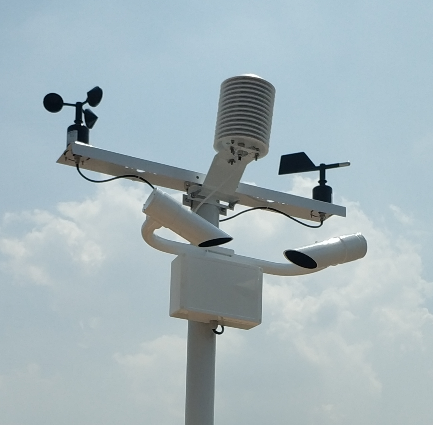In the world of precision agriculture, technology has revolutionized how farmers approach crop management, irrigation, and environmental control. One critical yet often overlooked factor that affects farming operations is wind speed. Wind can influence crop health, irrigation efficiency, and even the success of certain agricultural practices. To make better-informed decisions, farmers are increasingly relying on wind speed sensors to track and optimize conditions.

Wind plays a significant role in various agricultural processes, both positive and negative. Wind helps pollinate some crops naturally.
It also supports evaporation to control moisture and can reduce pest buildup. Excessive wind can harm crops and cause soil erosion. It can also make irrigation systems less effective.
Key factors that make wind speed essential in agriculture include:
Crop Health and Protection:
High wind speeds can physically damage crops, especially those that are young or delicate. Winds can cause physical stress, break stems, and even uproot plants in extreme cases. Understanding wind conditions helps farmers make timely decisions about crop protection and even choose the best planting times.
Irrigation Efficiency:
Wind can significantly affect irrigation systems. For instance, strong winds can cause water to evaporate quickly from overhead irrigation systems, leading to water wastage. By monitoring wind speed, farmers can optimize irrigation schedules and avoid inefficient watering practices.
Pollination and Pest Control:
Many crops depend on wind for pollination. Wind speed affects how effectively pollen travels between plants. Additionally, wind can disperse pest populations, both beneficial and harmful. By tracking wind conditions, farmers can improve their pest control strategies and better manage their crop's pollination needs.
Soil Erosion Management:
Wind can exacerbate soil erosion, especially in arid or semi-arid regions. Farmers can protect the soil by understanding wind speed and direction. They can plant windbreaks, use cover crops, or change tillage practices. These strategies help reduce wind erosion.
Wind speed sensors, also known as anemometers, are devices that measure the velocity of the wind. These sensors are typically part of weather stations placed across farms to monitor environmental conditions in real time.
Anemometers measure wind speed in meters per second or kilometers per hour. They give important data for making decisions. Many modern sensors integrate with automated farming systems, offering farmers instant insights into weather conditions that directly affect their operations.
Informed Decision-Making:
By tracking wind speed, farmers can make more informed decisions about irrigation, crop protection, and planting strategies. This leads to more efficient use of resources and better crop health.
Reduced Water Waste:
Wind speed sensors help farmers change irrigation schedules based on wind. This ensures water is used wisely and stops unnecessary evaporation.
Preventing Crop Damage:
Knowing when wind speeds will be too high helps farmers take action. They can reinforce buildings, add windbreaks, or stop irrigation to protect their crops.
Optimized Planting and Harvesting Times:
Wind conditions can impact planting and harvesting times, especially for crops that require delicate handling. Wind speed sensors provide valuable insights into the best windows for these operations.
Improved Environmental Monitoring:
Wind data is an essential component of a comprehensive environmental monitoring system. When you combine wind speed sensors with other weather data, you get a complete picture of conditions that affect crop growth.

Coda Sensor is leading the way in providing high-quality, reliable wind speed sensors designed for agricultural applications. Our sensors are made for accuracy and strength. They provide real-time wind data to help farmers manage crops and use resources better.
By incorporating Coda Sensor’s wind speed sensors into your farm’s environmental monitoring system, you can:
Accurately track wind conditions in real time.
Reduce crop damage and improve protection strategies.
Optimize irrigation and water usage based on wind data.
Make more informed decisions for planting, harvesting, and pest control.
Our solutions empower farmers to harness environmental data effectively, allowing them to increase operational efficiency, reduce costs, and promote sustainable farming practices. Coda Sensor’s wind speed sensors can help you succeed in farming. It doesn't matter if you have a small farm or a large agricultural business. These sensors are useful in today’s changing farming world.
Wind speed is very important in farming. It affects crop health, irrigation, pollination, and soil management. By using wind speed sensors, farmers can make data-driven decisions that not only protect crops but also maximize efficiency and sustainability in their operations. Coda Sensor’s wind speed sensors give accurate, real-time data. This helps farmers handle challenges and stay competitive in a complex agricultural industry.
Invest in the future of farming today with Coda Sensor’s advanced wind speed monitoring solutions.
Discover how real-time weather station data impr
Discover how Automatic Weather Stations (AWS) ar
Discover how CODA gas sensors are the invisible
Contact: Molly
Phone: +86-17775769236
Tel: 86-0731-85117089
Email: molly@codasensor.com
Add: Building S5, Aux Square, Yuelu District, Changsha City, Hunan Province, China
We chat